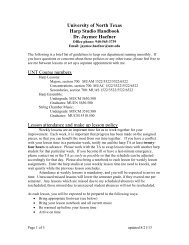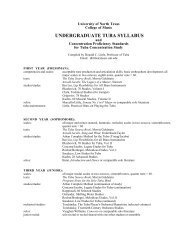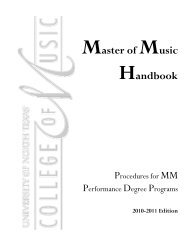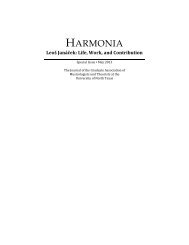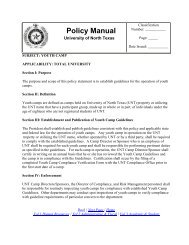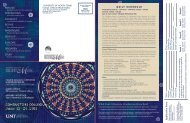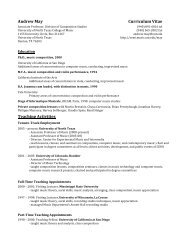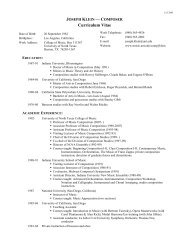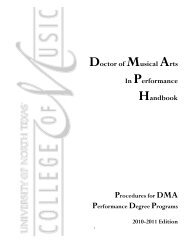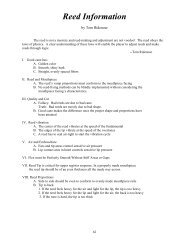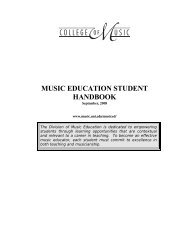7 Philippe Manoury's Jupiter1
7 Philippe Manoury's Jupiter1
7 Philippe Manoury's Jupiter1
You also want an ePaper? Increase the reach of your titles
YUMPU automatically turns print PDFs into web optimized ePapers that Google loves.
178 • Andrew May<br />
the opening of Section I. Fragmentary gestures alternate with rapid fi gures<br />
leading to either longer notes or rests. Th e latter extend the iterative behaviors<br />
of subsections I-A and I-B into new melodic regions. Th e computer<br />
follows suit, presenting longer segments of fast motoric rhythms. Th us, the<br />
fl ute line’s fragmentation is matched by increasingly active accompaniment<br />
by the computer. Th is developmental strategy itself mirrors the unfolding<br />
of the fi rst four subsections of Section I. In Section III, the musical gestures<br />
of Section II are further developed. Th e relational strategies used in Section<br />
II are simultaneously extended to include elements of other archetypes. Th e<br />
incipit-response patterns seen in subsections I-B and I-D are extended. Elements<br />
of subsections I-F and I-G are also developed here and woven together<br />
into a new texture at subsection III-F.<br />
Th e return to lyrical solo passages in Sections IV and VII, accompanied by<br />
temporal extension of fl ute notes, hearkens back to the opening and to subsections<br />
I-A, I-C, and I-E. Section XI extends the model of an accompanied<br />
solo with further orchestration and harmonic support from the computer.<br />
Th e fl ute opens Section XIII with an inversion of the opening solo melody,<br />
which introduces a foreshortened and enervated echo of Section I. Th e music<br />
briefl y recalls several of the initial archetypes, and a few elements of their<br />
development through the piece, before subsiding to the central C-sharp–G<br />
tritone of the opening.<br />
Even the computer’s most independent roles are outgrowths of the basic<br />
relationships established in Section I. Th e computer’s independent behaviors<br />
in Sections V and IX are a radical intensifi cation of the tactic of rhythmic<br />
activation used in subsections I-B and I-D. Th is is combined with extreme<br />
sonic and harmonic extension, as in subsection I-F when long rhythmic<br />
passages inhabit new timbres and registers that contrast strongly with the<br />
fl ute. While these sections are radically diff erent from the opening, elements<br />
of their sounds and behaviors can still be traced back to archetypes<br />
in Section I.<br />
In a strategic sense, the interpolation engine used in Sections V and IX<br />
actually positions the computer part much closer to the fl ute line than it<br />
would appear. Th e shape, speed, and trajectory of the interpolations mirror<br />
the fl utist’s interpretation of fi gures in Sections II and VII. If the fl utist’s<br />
performance is faster or slower, more regular or irregular, the interpolated<br />
sequences will follow that tendency. In this way, the fl utist is given authority<br />
in one section to control the real-time composition of another. Th e timbres<br />
in Sections V and IX obscure the close relationships between the fl ute’s<br />
interpretation of certain gestures and the computer’s reinterpretations of<br />
them. Th ese similarities are also hidden by the removal of the computer’s<br />
recording of gestures from their re-creation, since they occur in completely<br />
Simoni_RT76294_C007.indd 178 9/22/2005 11:19:26 AM




